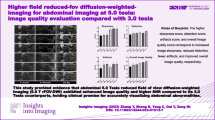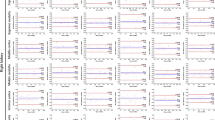Abstract
Objectives
To evaluate a new motion correction method, named RT + NV Track, for upper abdominal DWI that combines the respiratory triggering (RT) method using a respiration sensor and the Navigator Track (NV Track) method using navigator echoes.
Materials and methods
To evaluate image quality acquired upper abdominal DWI and ADC images with RT, NV, and RT + NV Track in 10 healthy volunteers and 35 patients, signal-to-noise efficiency (SNRefficiency) and the coefficient of variation (CV) of ADC values were measured. Five radiologists independently performed qualitative image-analysis assessments.
Results
RT + NV Track showed significantly higher SNRefficiency than RT and NV (14.01 ± 4.86 vs 12.05 ± 4.65, 10.05 ± 3.18; p < 0.001, p < 0.001). RT + NV Track was superior to RT and equal or better quality than NV in CV and visual evaluation of ADC values (0.033 ± 0.018 vs 0.080 ± 0.042, 0.057 ± 0.034; p < 0.001, p < 0.001). RT + NV Track tends to acquire only expiratory data rather than NV, even in patients with relatively rapid breathing, and can correct for respiratory depth variations, a weakness of RT, thus minimizing image quality degradation.
Conclusion
The RT + NV Track method is an efficient imaging method that combines the advantages of both RT and NV methods in upper abdominal DWI, providing stably good images in a short scan time.










Similar content being viewed by others
References
Vilgrain V, Esvan M, Ronot M, Caumont-Prim A, Aubé C, Chatellier G (2016) A meta-analysis of diffusion-weighted and gadoxetic acid-enhanced MR imaging for the detection of liver metastases. Eur Radiol 26:4595–4615
Katsuhiro N, Kuroki Y, Nawano S et al (2006) Hepatic metastases: diffusion-weighted sensitivity-encoding versus SPIO-enhanced MR imaging. Radiology 239:122–130
Taouli B, Koh D-M (2010) Diffusion-weighted MR Imaging of the liver. Radiology 254:47–66
Piana G, Trinquart L, Meskine N, Barrau V, Van Beers B, Vilgrain V (2011) New MR imaging criteria with a diffusion-weighted sequence for the diagnosis of hepatocellular carcinoma in chronic liver diseases. J Hepatol 55:126–132
Vandecaveye V, De Keyzer F, Verslype C et al (2009) Diffusion-weighted MRI provides additional value to conventional dynamic contrast-enhanced MRI for detection of hepatocellular carcinoma. Eur Radiol 19:2456–2466
American College of Radiology. Liver Reporting & Data System (LI-RADS®) https://www.acr.org/Clinical-Resources/Reporting-and-Data-Systems/LI-RADS%0A%0A. Accessed: 18 Aug 2022
Van Den Bos IC, Hussain SM, Krestin GP, Wielopolski PA (2008) Liver imaging at 3.0 T: Diffusion-induced black-blood echo-planar imaging with large anatomic volumetric coverage as an alternative for specific absorption rate-intensive echo-train spin-echo sequences: feasibility study. Radiology 248:264–271
Coenegrachts K, Delanote J, Ter Beek L et al (2007) Improved focal liver lesion detection: comparison of single-shot diffusion-weighted echoplanar and single-shot T2 weighted turbo spin echo techniques. Br J Radiol 80:524–531
De Robertis R, Tinazzi Martini P, Demozzi E et al (2015) Diffusion-weighted imaging of pancreatic cancer. World J Radiol 7:319–328
d’Assignies G, Fina P, Bruno O et al (2013) High sensitivity of diffusion-weighted mr imaging for the detection of liver metastases from neuroendocrine tumors: comparison with t2-weighted and dynamic gadolinium-enhanced mr imaging. Radiology 268:390–399
Roth Y, Tichler T, Kostenich G et al (2004) High-b value diffusion-weighted MR imaging for pretreatment prediction and early monitoring of tumor response to therapy in mice. Radiology 232:685–692
Obara M, Kwon J, Yoneyama M et al (2023) Technical advancements in abdominal diffusion-weighted imaging. Magn Reson Med Sci 22:191–208
Naganawa S, Kawai H, Fukatsu H et al (2005) Diffusion-weighted imaging of the liver: technical challenges and prospects for the future. Magn Reson Med Sci 4:175–186
Ichikawa T, Haradome H, Hachiya J et al (1998) Diffusion-weighted MR imaging with a single-shot echoplanar sequence: detection and characterization of focal hepatic lesions. AJR Am J Roentgenol 170:397–402
Taouli B, Chouli M, Martin AJ et al (2008) Chronic hepatitis: role of diffusion-weighted imaging and diffusion tensor imaging for the diagnosis of liver fibrosis and inflammation. J Magn Reson Imaging 28:89–95
Girometti R, Furlan A, Bazzocchi M et al (2007) Diffusion-weighted MRI in evaluating liver fibrosis: a feasibility study in cirrhotic patients. Radiol Med (Torino) 112:394–408
Parikh T, Drew SJ, Lee VS et al (2008) Focal liver lesion detection and characterization with diffusion-weighted MR imaging: comparison with standard breath-hold T2-weighted imaging. Radiology 246:812–822
Choi JS et al (2013) Comparison of breathhold, navigator-triggered, and free-breathing diffusion-weighted MRI for focal hepatic lesions. J Magn Reson Imaging 38:109–118
Kwee TC, Takahara T, Koh DM, Nievelstein RAJ, Luijten PR (2008) Comparison and reproducibility of ADC measurements in breathhold, respiratory triggered, and free-breathing diffusion-weighted MR imaging of the liver. J Magn Reson Imaging 28:1141–1148
Takayama Y, Nishie A, Asayama Y et al (2015) Optimization and clinical feasibility of free-breathing diffusion-weighted imaging of the liver: comparison with respiratory-triggered diffusion-weighted imaging. Magn Reson Med Sci 14:123–132
Chen X, Qin L, Pan D et al (2014) Liver diffusion-weighted MR imaging: reproducibility comparison of ADC measurements obtained with multiple breath-hold, free-breathing, respiratory-triggered, and navigator-triggered techniques. Radiology 271(1):113–125
Xie S, Masokano IB, Liu W et al (2021) Comparing the clinical utility of single-shot echo-planar imaging and readout-segmented echo-planar imaging in diffusion-weighted imaging of the liver at 3 tesla. Eur J Radiol 135:109472
Bruegel M, Holzapfel K, Gaa J et al (2008) Characterization of focal liver lesions by ADC measurements using a respiratory triggered diffusion-weighted single-shot echo-planar MR imaging technique. Eur Radiol 18:477–485
Nasu K, Kuroki Y, Sekiguchi R, Nawano S (2006) The effect of simultaneous use of respiratory triggering in diffusion-weighted imaging of the liver. Magn Reson Med Sci 5:129–136
Kandpal H, Sharma R, Madhusudhan KS, Kapoor KS (2009) Respiratory-triggered versus breath-hold diffusion-weighted MRI of liver lesions: comparison of image quality and apparent diffusion coefficient values. AJR Am J Roentgenol 192:915–922
Taouli B, Sandberg A, Stemmer A et al (2009) Diffusion-weighted imaging of the liver: comparison of navigator triggered and breathhold acquisitions. J Magn Reson Imaging 30:561–568
Gourtsoyianni S, Papanikolaou N, Yarmenitis S et al (2008) Respiratory gated diffusion-weighted imaging of the liver: value of apparent diffusion coefficient measurements in the differentiation between most commonly encountered benign and malignant focal liver lesions. Eur Radiol 18:486–492
Choi JS, Kim MJ, Chung YE et al (2013) Comparison of breath-hold, navigator-triggered, and free-breathing diffusion-weighted MRI for focal hepatic lesions. J Magn Reson Imaging 38:109–118
Li C, Magland JF, Rad HS et al (2012) Comparison of optimized soft-tissue suppression schemes for ultra-short echo time (UTE) MRI. Magn Reson Med 68:680–689
Mürtz P, Flacke S, Träber F et al (2002) Abdomen: diffusion-weighted MR imaging with pulse-triggered single-shot sequences. Radiology 224:258–264
Nasu K, Kuroki Y, Sekiguchi R et al (2006) Measurement of the apparent diffusion coefficient in the liver: is it a reliable index for hepatic disease diagnosis? Radiat Med 24:438–444
Kandpal H, Sharma R, Madhusudhan KS et al (2009) Respiratory-triggered versus breath-hold diffusion-weighted MRI of liver lesions: comparison of image quality and apparent diffusion coefficient values. AJR Am J Roentgenol 192:915–922
Wang YXJ, Huang H, Zheng CJ et al (2021) Diffusion-weighted MRI of the liver: challenges and some solutions for the quantification of apparent diffusion coefficient and intravoxel incoherent motion. Am J Nucl Med Mol Imaging 11(2):107–142
Kartalis N, Manikis GC, Loizou L et al (2016) Diffusion-weighted MR imaging of pancreatic cancer: a comparison of mono-exponential, bi-exponential and non-Gaussian kurtosis models. Eur J Radiol Open 3:79–85
Sénégas J, Krueger S, Wirtz D, et al. (2018) Comparison of liver motion measured by dynamic MRI and respiration signals obtained by an optical sensor. In: Proceedings of the 26th annual meeting Intl Soc Mag Reson Med (ISMRM), Paris. p. 2528.
Harder F, Lohöfer FK, Kaissis GA et al (2019) Camera-based respiratory triggering improves the image quality of 3D magnetic resonance cholangiopancreatography. Eur J Radiol 120:108675
Takano S, Horie T, Endo K et al (2013) Problem of spectral attenuated with inversion recovery fat suppression method with respiratory-gated. Jpn J Radiol Technol 61:92–98. https://doi.org/10.6009/jjrt.2013_JSRT_69.1.92
Funding
This research did not receive any specific grant from funding agencies in the public, commercial, or not-for-profit sectors.
Author information
Authors and Affiliations
Corresponding author
Ethics declarations
Conflict of interest
Hiroshi Hamano is an employee of Philips Japan.
Ethical statement
The study was approved by the institutional review board, and written informed consent was obtained from all subjects. Approval number: 22I-0302-004.
Additional information
Publisher's Note
Springer Nature remains neutral with regard to jurisdictional claims in published maps and institutional affiliations.
Supplementary Information
Below is the link to the electronic supplementary material.
VIDEO 1 In the FB method, accurate ADC images were often difficult to obtain due to respiratory misregistration between low b and high b values, and large differences in ADC values between slices were observed (MP4 6645 KB)
VIDEO 2 In the RT method, image quality degradation due to variations in the depth of respiration was observed for both DWI (b1000) and ADC images. Accurate ADC images of the lesion were not obtained due to respiratory misregistration between low and high b values (MP4 5293 KB)
VIDEO 3 In the NV method, poor reading of the navigator due to magnetic field inhomogeneity caused delayed trigger timing, and data acquisition included data from inspiration, resulting in poor image quality at the superior margin of the liver in both the DWI and ADC images (MP4 3718 KB)
VIDEO 4 In both DWI (b1000) and ADC images, RT+NV Track and NV showed good image quality, but RT showed uneven liver signal intensity between slices due to variations in the depth of respiration (MP4 6238 KB)
VIDEO 5 RT showed artifacts due to poor fat suppression in DWI (b1000) images. In NV, uneven liver signal intensities were observed between slices, and two sequential slices were the same position in both DWI and ADC images due to the inclusion of inspiratory data in the data acquisition. RT+NV Track showed good image quality without artifacts (MP4 5668 KB)
VIDEO 6 In RT, both DWI (b1000) and ADC images showed significant kidney signal intensity unevenness between slices due to variations in respiration. In NV, both DWI (b0) and ADC images showed significant signal intensity unevenness in the liver lesion and spleen between slices. RT+NV Track showed good image quality without artifacts (MP4 6130 KB)
Rights and permissions
Springer Nature or its licensor (e.g. a society or other partner) holds exclusive rights to this article under a publishing agreement with the author(s) or other rightsholder(s); author self-archiving of the accepted manuscript version of this article is solely governed by the terms of such publishing agreement and applicable law.
About this article
Cite this article
Tachikawa, Y., Hamano, H., Chiwata, N. et al. Diffusion weighted imaging combining respiratory triggering and navigator echo tracking in the upper abdomen. Magn Reson Mater Phy (2024). https://doi.org/10.1007/s10334-024-01150-1
Received:
Revised:
Accepted:
Published:
DOI: https://doi.org/10.1007/s10334-024-01150-1




